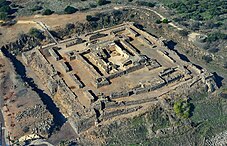
Achziv or Az-Zeeb is an ancient site on the Mediterranean coast of northern Israel, between the border with Lebanon and the city of Acre. It is located 13.5 kilometres (8.4 mi) north of Acre on the coast of the Mediterranean Sea, within the municipal area of Nahariya. Today it is an Israeli national park.

Antipatris was a city built during the first century BC by Herod the Great, who named it in honour of his father, Antipater. The site, now a national park in central Israel, was inhabited from the Chalcolithic Period to the late Roman Period. The remains of Antipatris are known today as Tel Afek, although formerly as Kŭlat Râs el 'Ain. It has been identified as either the tower of Aphek mentioned by Josephus, or the biblical Aphek, best known from the story of the Battle of Aphek. During the Crusader Period the site was known as Surdi fontes, "Silent springs". The Ottoman fortress known as Binar Bashi or Ras al-Ayn was built there in the 16th century.

Khirbat Jiddin, known in the Kingdom of Jerusalem as Judin, was an Ottoman fortress in the western Upper Galilee, originally built by the Teutonic Order after 1220 as a crusader castle, 16 km northeast of the city of Acre, which at the time was the capital of the Kingdom of Jerusalem. The castle was destroyed by the Mamluk sultan Baibars sometime between 1268-1271 and lay in ruins until being rebuilt and expanded by the Arab ruler Zahir al-Umar as Qal'at Jiddin in the 1760s, only to be destroyed again around 1775 by Jazzar Pasha. The ruined fortress, known as Khirbat Jiddin, was later inhabited by the al-Suwaytat Bedouin tribe.

Safed is a city in the Northern District of Israel. Located at an elevation of up to 937 m (3,074 ft), Safed is the highest city in the Galilee and in Israel.

Apollonia, known in the Early Islamic period as Arsuf and in the Crusader Kingdom of Jerusalem as Arsur, was an ancient city on the Mediterranean coast of today's Israel. In Israeli archaeology it is known as Tel Arshaf. Founded by the Phoenicians during the Persian period in the late sixth century BCE, it was inhabited continuously until the Crusader period, through the Hellenistic, Roman, and Byzantine periods, during the latter being renamed to Sozusa. It was situated on a sandy area ending towards the sea with a cliff, about 34 kilometres (21 mi) south of Caesarea.

The Nimrod Fortress or Nimrod Castle is a castle built by the Ayyubids and hugely enlarged by the Mamluks, situated on the southern slopes of Mount Hermon, on a ridge rising about 800 m above sea level. It overlooks the Golan Heights and was built with the purpose of guarding a major access route to Damascus against armies coming from the west.

Belvoir Castle, also called Coquet by the Crusaders, also Kochav HaYarden and Kawkab al-Hawa, is a Crusader castle in northern Israel, on a hill on the eastern edge of the Issachar Plateau, on the edge of Lower Galilee 20 kilometres (12 mi) south of the Sea of Galilee. Gilbert of Assailly, Grand Master of the Knights Hospitaller, began construction of the castle in 1168. The castle ruin is located in Belvoir National Park, officially Kochav HaYarden National Park. It is the best-preserved Crusader castle in Israel.
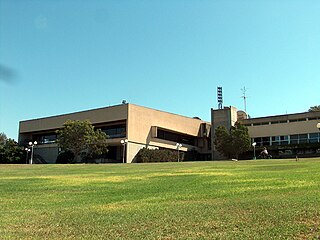
Kabri is a kibbutz in northern Israel. Located in the Western Galilee about 4 kilometres (2 mi) east of the Mediterranean seaside town of Nahariya, it falls under the jurisdiction of Mateh Asher Regional Council. In 2022 it had a population of 1,120.

Tourism in Israel is one of the country's major sources of income, with a record 4.55 million tourist arrivals in 2019. Tourism contributed NIS 20 billion to the Israeli economy in 2017, making it an all-time record. Israel offers a plethora of historical and religious sites, beach resorts, natural sites, archaeological tourism, heritage tourism, adventure tourism, and ecotourism. For practical reasons, this article also covers tourism in the Israeli-occupied West Bank and the occupied Golan Heights, since it is closely interconnected with the mass tourism in Israel. Over the millennia, the Holy Land has been amongst the most visited lands in the world.
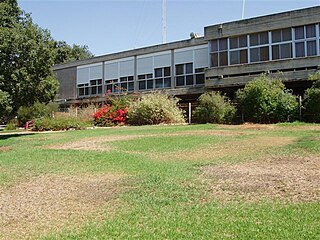
Yehiam is a kibbutz in northern Israel. Located at the western Upper Galilee, eight miles east of the coastal town of Nahariya and 14 miles south-east of the border with Lebanon it falls under the jurisdiction of Mateh Asher Regional Council. In 2022 it had a population of 778. It is located around 365 meters above sea level

Château Pèlerin, also known as Atlit and Magdiel, is a Crusader fortress and fortified town located about 2 kilometres (1.2 mi) north of the modern Israeli town of Atlit on the northern coast of Israel, about 13 kilometres (8.1 mi) south of Haifa.
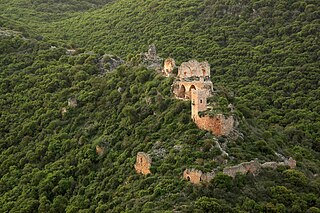
Montfort is a ruined Crusader castle in the Upper Galilee region in northern Israel, about 22 miles (35 km) northeast of the city of Haifa and 10 miles (16 km) south of the border with Lebanon.

Qaqun was a Palestinian Arab village located 6 kilometers (3.7 mi) northwest of the city of Tulkarm at the only entrance to Mount Nablus from the coastal Sharon plain.
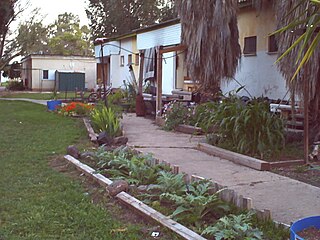
Neve Ur is a kibbutz in northern Israel. Located in the Beit She'an Valley on the Jordan River and to the south of the Sea of Galilee, it falls under the jurisdiction of Valley of Springs Regional Council. In 2022 it had a population of 356.

Migdal Afek, also Migdal Tsedek, is a national park on the southeastern edge of Rosh HaAyin, Israel. It is the site of the depopulated Palestinian village of Majdal Yaba.

Majdal Yaba was a Palestinian Arab village in the Ramle Subdistrict, 18.5 kilometres (11.5 mi) northeast of Ramla and 4 kilometres (2.5 mi) east of Jaffa. A walled Jewish settlement name Migdal Aphek stood at the same site as early as the second century BCE, and it was later destroyed by the Romans during the First Jewish–Roman War in 67 CE. In the Crusader period, a fort named Mirabel was built at the site. During the Islamic period it became known as Majdal Yaba. For a short time under Ottoman rule, its name was changed from Majdal Yaba to Majdal Sadiq and then back again.

Ein Hemed is a national park and nature reserve in the hills seven kilometres west of modern Jerusalem and some 12 kilometres west of the Old City. It is also known by the Latin name it received from the Crusaders, Aqua Bella, and as Khirbat Iqbalā in Arabic. The park is located on the path of an old Roman road, also used in later periods. The road connected the coastal plain with Jerusalem, passing through Bab al-Wad. A fortified Hospitaller building from the Crusader period, relatively well preserved, is arguably the main attraction beside the streams and lush vegetation.
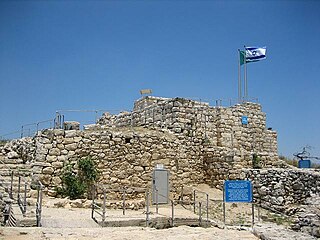
Castel National Park is an Israeli national park, which consists of a fortified summit in the Judean Mountains, at the site of the former Palestinian village of Al-Qastal, known to Hebrew-speakers as HaCástel, "the Cástel". It is located 8 km west of Jerusalem on the road linking it to Tel Aviv.

Yehi'am Fortress National Park is an Israeli national park in western Upper Galilee on the grounds of Kibbutz Yehi'am, whose main attractions are the ruins of a hilltop castle in Jiddin. The castle, ruined in the early 14th century, became a small town known as Khirbat Jiddin; the town was depopulated in 1948.

